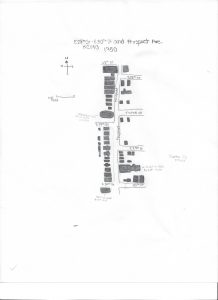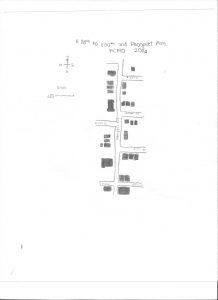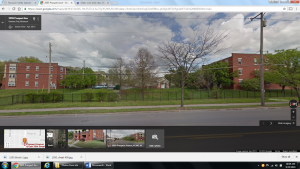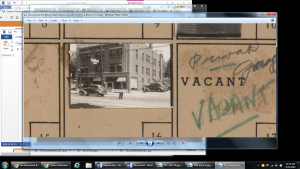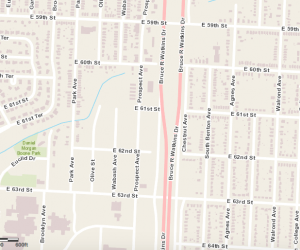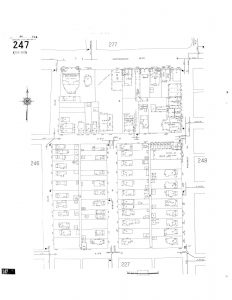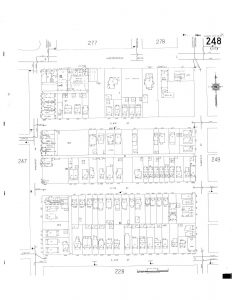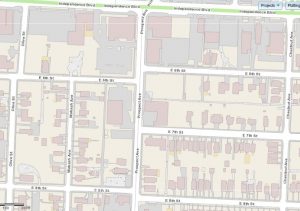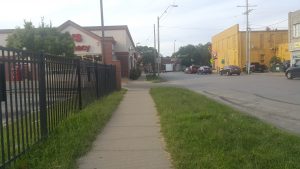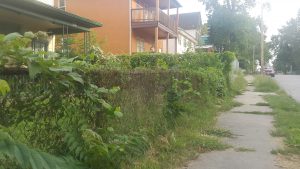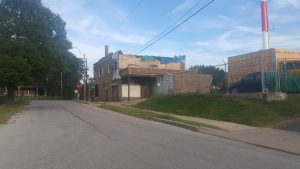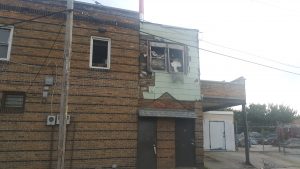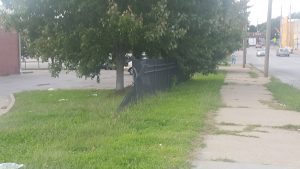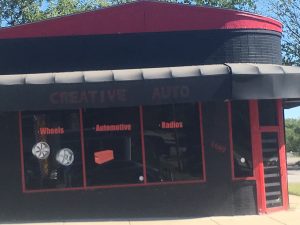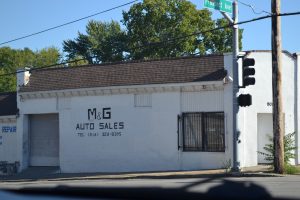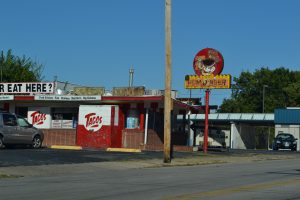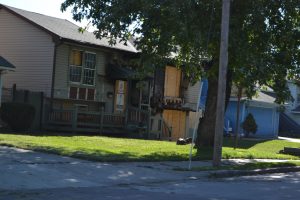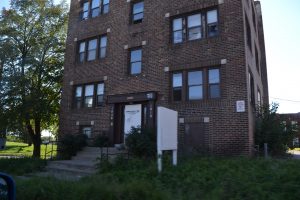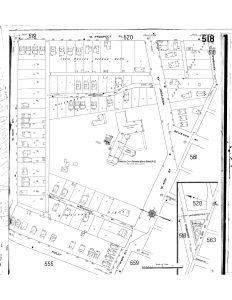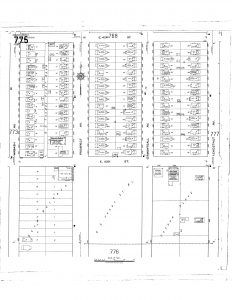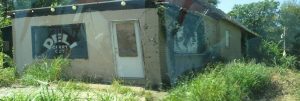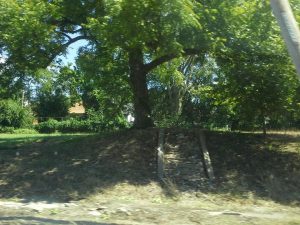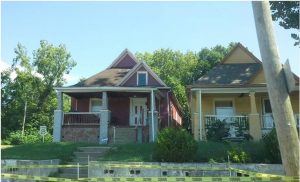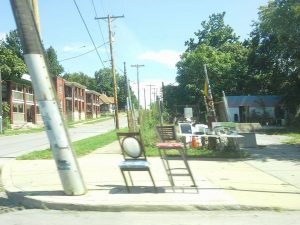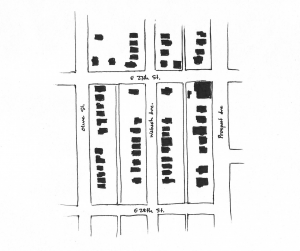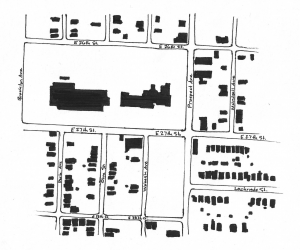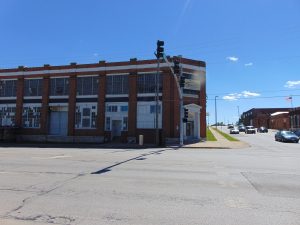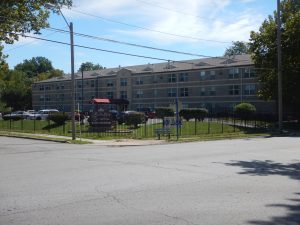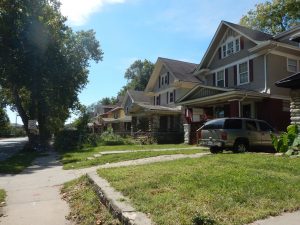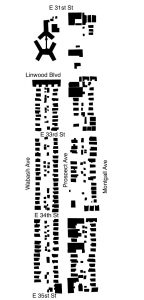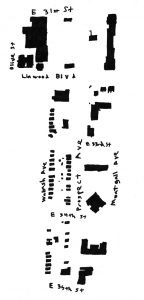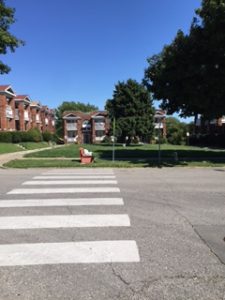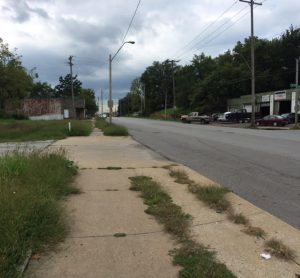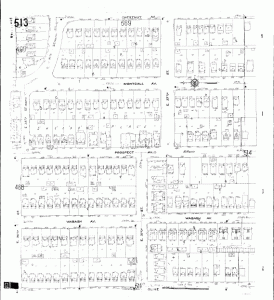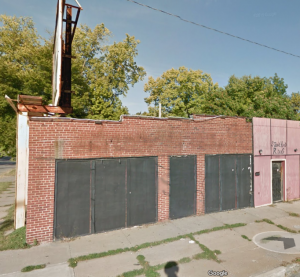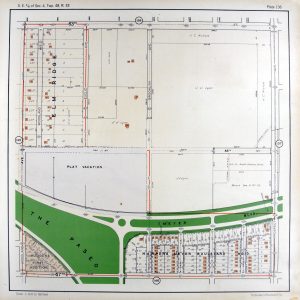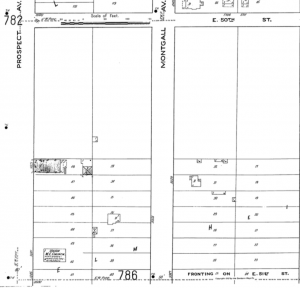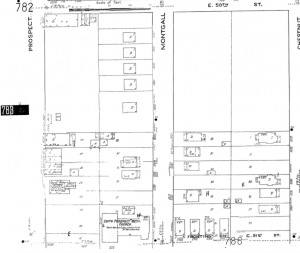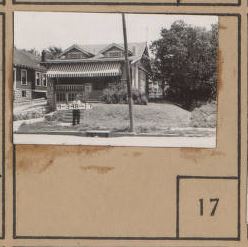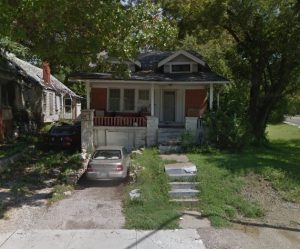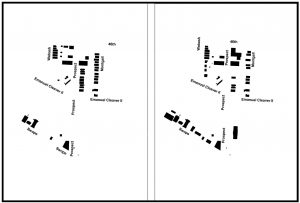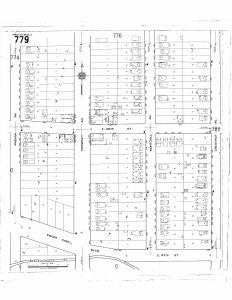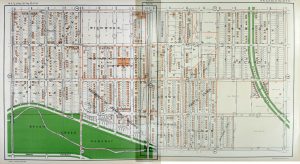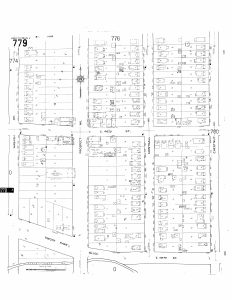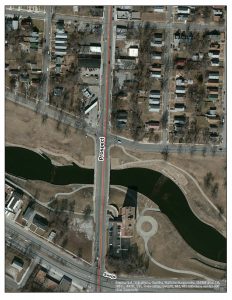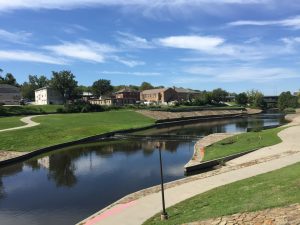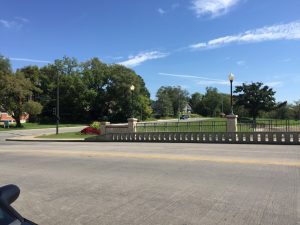Blocks E. 28th St. – E. 30th St. and Prospect Ave. have undergone a period with a clear trend of growth up until the 1950’s, as indicated by the increase in number of structures and the density of the buildings in the Sanborn Maps and KC Atlas. I had trouble locating the 1895-1896 maps but in the 1907 Sanborn maps a lot of building were already in place. In contrast when looking at 2016, very little of the original structures remain and a decline in the number of structures and density had occurred. Researching articles for the history of the area suggest that crime could be a cause for the decline. In 1968 Kansas City was the center for a riot. I located historical newspaper articles describing shootings that took place, men that were killed and buildings that were burn down in my blocks. Since then it appears that the area has never recovered as evidence by the series of maps. More recently, a man by the name of Jimmy Townsend was shot at his home located at 2900 block of Prospect Ave. Townsend operated Jimmy’s and Dee’s Steakhouse that used to be located at E. 29th Street and Prospect Avenue. It was part of cluster of businesses along Prospect Ave. that included the Byron Hotel that was located on the east side of Prospect Ave. between E. 29th St and E. 30th St. At Byron Hotel four men were killed in the riots that followed the April 1968 assassination of Martin Luther King Jr. Jimmy Townsend was a figure in this area and his shooting shows that unfortunately this area remains an area of crime today which may be a large account for the decline.
Monthly Archives: September 2016
62nd and Brooklyn Ave.
I examined 62nd and Brooklyn Ave to the West of Prospect and also a little of North up until 59th Street as well. I had difficulties allocating maps for my area due to its lack of development up until 1925 (Atlas.) This was the first indication of structures in that area, but it was still documented in an Atlas and not a Sanborn Map. the area was primarily residential with single-family dwellings from what I could tell f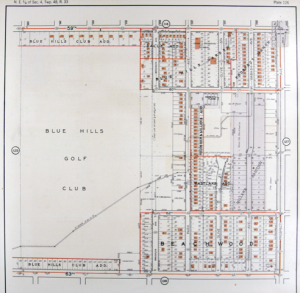 rom the lot sizes and structures.
rom the lot sizes and structures.
As the neighborhood progressed there were several new residential homes added up until 1939, and then the timeline gets a little hazy. From 1939, the last documented Sanborn map shows a decline in development and actually a staggering amount of demolition to the block on 62nd.
Though it wasn’t noted in my paper due to lack of evidence to support it, I’m going to mention it hear as a controversial factor to 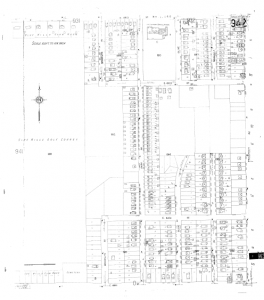 this deconstruction of the neighborhood along Prospect Ave. There is a pretty concise grid network through Kansas City and the construction of US 71 (Bruce R. Watkins Expressway), which extends North to South, cuts through this grid. In my opinion, my block suffered from this segregation and physical barrier, relocating many residents in the area.
this deconstruction of the neighborhood along Prospect Ave. There is a pretty concise grid network through Kansas City and the construction of US 71 (Bruce R. Watkins Expressway), which extends North to South, cuts through this grid. In my opinion, my block suffered from this segregation and physical barrier, relocating many residents in the area.
Synopsis of Analysis for Prospect Avenue from 52nd Street to 54th Street
Walking through Prospect Avenue from 52nd Street to 54th Street today we find a mix of residencies and businesses sporadically located. The residencies have little space between them and are similar in size. However, some of the businesses have large properties or are by a vacant property. There is an auto shop, a dental clinic, a discount merchandise store, a party shop, a motel, a restaurant and a laundromat.
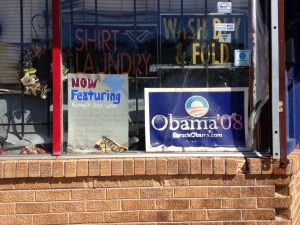
On the West side of Prospect for these blocks, the 1925 Atlas and Sanborn maps c.1950 volume 9 and volume 6, show that landlords of certain sections on these blocks, divided the area into grid-like compartments and placed buildings in the compartments. These compartmentalized sections, shared the land on the block with a landlord, Mary S Smeltzer who kept her section unbuilt and undivided. The East side of Prospect for these blocks show a similar division of land use. However, the 1925 Atlast shoes an interesting set of buildings were located Prospect and 54th Street — Wheatley School. The school was name after Phillis Wheatley and was for African Americans. The c1950 Sanborn maps show that the school moved two blocks East and in parenthesis classifies it as “colored”. It also showed that the buildings for Wheatley School by prospect were not there anymore by then.

Today, there still is a mix of compartmentalized residency buildings and unkept, empty sections of land on these blocks.
Prospect and E 11th St through E 13th St
My blocks were primarily used for commercial purposes. I saw a BP gas station, a Church’s Chicken, a police gas station, a life insurance building, a car dealership, a women’s center, and Prospect Plaza Park. The area was pretty busy and the park was well-maintained. 12th St had the most traffic traveling east and west. When I did my figure-ground study, the area was not very dense, mainly because parking lots took up so much space instead of buildings.
When I looked back at the historical maps of the area, I was surprised to see it had mostly been residential single-family homes, a different apartment complex (now gone), and a large Catholic Church. I asked a friend about the church and he was surprised to hear it was gone. After doing some digging, the church closed down because it didn’t have a large enough following anymore. It appears people are moving away and businesses are moving in.
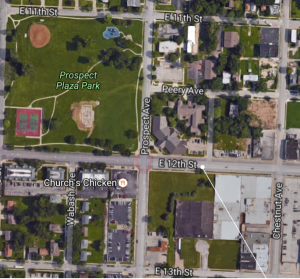
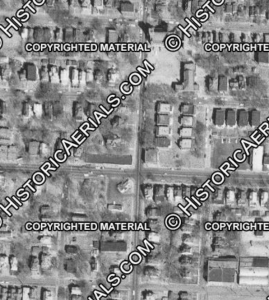
Independence Ave and E 8th St.
My assigned area at first glance looked old and not taken care of, backing up what I’m saying it turns out to be this block and blocks adjacent to it go back to the 1800’s when they were first built. Down below some pictures I’ve taken that show the conditions of the neighborhood where you could clearly see between E 6th and 7th St the tall grass, trash, bended fences, however, it would look better near Independence Ave where the CVS is which did not exist until 1999.
However, studying the sanborn maps showed quiet differences between 1909 and 2016 building footprints. Few houses were built, others were taken down and replaced with commercial buildings or parking spaces. Density decreased nowadays than what it used to be in 1925. I wished I had more time, and not so much work to do for studio 3rd year, to look deep into why exactly those changes occurred, but that’s as far as I went.
Either side of Prospect and between Independence and Amie/Elma streets
The two blocks between Independence Avenue and Amie Street/Elma Street, on either side of Prospect Avenue, are a primarily Suburban family area with almost 40% multi-unit homes. North from the blocks is Garfield elementary school, which is a rebuild of the original school established in the late 1800s.
A random sampling of 12 single-family houses within the two blocks puts the average cost of each one at about $86,000. Observing the neighborhoods, the cars are all used, there are a few houses that are condemned, and the majority of the parking is off-street. The lots are small. The neighborhood is close to Independence although it is in Kansas City. Bus 24 runs along Independence Avenue, making the neighborhood accessible to people without cars. Snyder’s grocery is on the southern portion of the block between Prospect and Montgall Ave. There are a few other businesses across the street, such as a Halal mart. The area has the necessities for a family to survive, but not thrive.
There are less buildings than there were in the 50s, in particular, some apartment buildings were repurposed such as in Amie Court, and others, such as at Stonewall Apartments, burned down in 2015. There are also less, but larger houses, and other structures on plots of land such as sheds and such have been taken down. However there are significantly more than there were around the turn of the century.
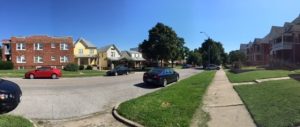
Prospect, 56th through 58th
The area of prospect between 56th and 58th streets seems to have been heavily influenced by both the past commerce of the area, as well as the city’s development as a whole. In the 1937 Sandborn Map, one of the only businesses shown was a garage for vehicles. Now in the present day, almost the entirety of this stretch has been dedicated in some way to the automotive industry. The original garage is still standing, and many of the structures have been removed or replaced with either used car lots, repair shops, or some other automotive based company. Many of the residential areas are no longer being used, I believe that this is due to the removal of a portion of the once adjacent street, Montgall, in order for interstate 71 to be installed. This has led to this portion of Prospect Ave being less used for residential purposes and led way for more businesses to move in and take the space.
Prospect Ave and 8th-11th St
My area along Prospect Ave is a very interesting one. When I did my research of this particular area, the Sanborn maps showed it developing quite nicely with more and more developers buying up land because it was the place to be. But, over time, there has been a definite lack of new growth and development. It was clearly shown that old complexes and houses were traded in, torn down and replaced with low level commercial that kind of signaled the down fall of this area. If you visit this area today, you’ll find lots upon lots of abandoned buildings, apartment complexes, or just empty ones that are overgrown. There is a feeling of neglect and nostalgia of “what once was”. The time, money and care haven’t been put into this area anymore.
42nd through 44 Historical Development
The Map on the left is a Sanborn Map from 1909 showing 42nd street to Prospect and the Map on the right is a 1917 Sanborn Map. With the Map on the left showing roads that angle, they were reconstructed sometime between 1909 and 1917 to form a more grid like pattern. With new construction of the block came more lots that are formal to each other throughout the block. This made it easier to sell for dwellings on the evenly divided lots. The 1917 Sanborn map is what the block looks like currant day with a few less houses.
Prospect between 21st and 24th Street
Analysis of Prospect Avenue: E 26th to E 28th
Beginning in the intersection of east 26th and Prospect Avenue, looking at the Digital Sanborn maps from 1885 to 1896, not a lot of the land was at use. In comparison to the maps from 1909, a lot of new structures were built within that time period. There appeared to be at least one structure per parcel. The buildings proximity to the street has seemed to have a decent amount of setback, possibly due to the refinishing of the roads over the years.
When looking at the figure ground diagrams, it is easy to see how much has developed over time since the late 1800’s, and as of recent years. Back when there was not a lot of land being put to use, there was less traffic around the area. And when looking at the most recent figure ground on the right, roads have been annexed in order to fit bigger buildings, like the Kansas City Police Crime Lab.
One of the buildings that has great history in the area, is The Green Duck lounge that is located on 26th and Prospect. This lounge has had made Kansas City history as it was the place in which one of Kansas City’s well known civil rights leader Leon Jordan, was murdered outside the lounge. The Green Duck has had a rough past of having numerous murders happen around the premise, and since then has closed, as the owner, Jimmy Townsend had similarly faced the same fate as what many have at the doors of his business, in late 2015.
As of recent, there has been new construction in the intersection of 27th an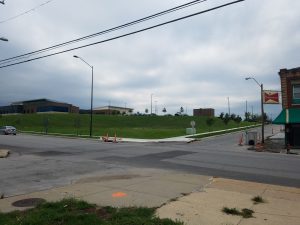 d Prospect. Two new buildings, the Kansas City Police Crime Lab, and one that is currently still being developed. When visiting this area, I was astonished by how the different this area was in comparison to the surrounding area. Of course when new construction is almost finished, there is new grass planted, as well as some greenery to help liven the area. But once you pass the area, east or west, the neighborhoods look as they need to have the same treatment.
d Prospect. Two new buildings, the Kansas City Police Crime Lab, and one that is currently still being developed. When visiting this area, I was astonished by how the different this area was in comparison to the surrounding area. Of course when new construction is almost finished, there is new grass planted, as well as some greenery to help liven the area. But once you pass the area, east or west, the neighborhoods look as they need to have the same treatment.
Prospect Avenue: 40th Street Through 42nd Street


The majority of the structures on these blocks are single-family residences with a handful of stores and local businesses, including a corner convenience store and a barber shop. The area appears to have maintained its overall intended land-use structure, as shown on the 1917 Sanborn map, but has undergone drastic changes between the issue of the 1951 Sanborn Map and its current physical state.
Between these two time periods, 30 total structures have been demolished, and the lots on which these properties sat remain vacant to this day without any visible efforts in rebuilding. With the 2008 recession and the nationwide housing crisis, the countless number of foreclosures made it easy for owners to abandon neglected structures. After 5 years of tax delinquency, a property is then turned over to the city. Many of them require more repairs than the city has funds to support. Therefore, the city of Kansas City, Missouri has been working tirelessly to raiz these eyesores, which have also been known to house prostitutes, drug dens, and even dead bodies.
Working on a limited amount of funds, the progress is relatively slow given the amount of properties continually turned over to the city. The fact that these particular blocks have seen numerous single efforts to improve their integrity shows great hope for lowering crime rates and improving the livelihood of residents and prosperity of the area.
E 50th and Prospect Historical Development Analysis
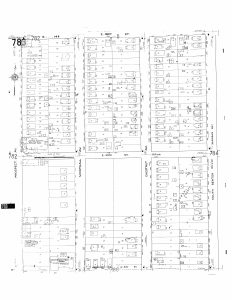
E 50th and Prospect Ave
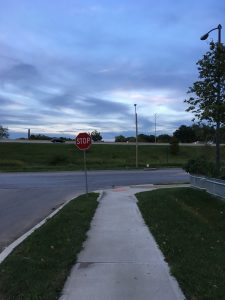
The Eastern block of Prospect Ave from Swope Parkway to 50th Street is predominately covered by Highway 71 except for the corner of Prospect Ave and Swope Parkway where a Shell gas station exist, North of the 71 Hwy overpass. This link provides a visual for comparison between 1950 and present day. 2016 KCMO. Based on the 1917 and 1950 Sanborn Maps Swope parkway to E 50th Street had a full block of commercial buildings and homes till the construction of the highway. Now the space feels mostly empty, noisy from Hwy 71 traffic, with moderately maintained green space and a bus stop. Additional lighting could be provided under the overpass to give a sense of safety to pedestrians. The Western side of Prospect Ave could be developed into urban gardens, and sound barriers can be constructed along the highway to reduce noise.
Along Prospect Avenue from Truman Road to 18th Street
Today the land from Truman road to 18th street along Prospect Avenue is an industrial business area. It is no longer a residential neighborhood as it was in 1909. Back in time this area was full of medium sized residential homes as well as Woolf Brothers Steam Laundry company . Some of the homes in this area had horse stables behind them. There were also alleys behind the buildings enabling access to the stables for the horses and carriages .The Sanborn maps in figure 1 and 2 (1909 pp. 309,322) show what the area looked like in 1909. There are 13 empty lots with the majority of structures being homes.
( 1909 Sanborn Vol. 3 pp. 309)
( 1909 Sanborn Vol. 3 pp. 322)
Today the area is much different and is composed mainly of businesses. Currently the businesses in this area are Indicia, a branding firm,Uplift, an organization that helps the homeless,Blue Valley Industries, for the mentally disabled,MCC faculty services and Heartland Department for Behavioral Change. ,The only building that is still standing from 1909 is the former Woolf Brothers Steam Laundry, today it is used by Walker Towel and Uniform Service Inc. (figure 2)
The blocks along Prospect Avenue from Truman road to 18th street have changed from a budding residential area to an industrial business section of Kansas City . After researching the history of the buildings in this area it has made me wonder what life would have been like living along Prospect in 1909.
Prospect Avenue From Linwood Boulevard to E 34th Street
Prospect Avenue From Linwood Boulevard to E 34th Street
My blocks on Prospect Avenue extended from Linwood Boulevard to East 34th Street. In the present, there are many defining features that describe my blocks. There are heavy-duty metal gates that fence in large areas around apartment buildings and businesses. These buildings are concentrated on the East and West sides of Prospect Avenue from Linwood Boulevard to East 33rd Street as well as the East side of Prospect Avenue from East 33rd Street to East 34th Street. The West side of Prospect Avenue from East East 33rd Street to East 34th Street is all single family residential houses. Many of these homes are relatively close tother compared to others on the block. A couple houses were vacant, with one of the vacant buildings being labeled as a “dangerous building” A large portion of the single family homes were similar in style to a shirtwaist house.
Gates Around Apartment Complex
Shirtwaist Houses
Before 1895, my blocks were outside of city limits at the edge of development. By 1909, the area was filling up, primarily with residential development with the exception of two greenhouses. The residences were primarily single family dwellings and were not nearly as dense as they are today. More buildings had been built by 1925. More residences had been built as well as a few businesses. By 1951, a few more residences had been built, but this also marks the appearance of smaller secondary structures behind some of the residences. This time period is the first evidence in my blocks where structures were demolished and replaced with drastically different buildings. Namely, the two greenhouses and a few other buildings on that block were torn down and replaced. Now, in 2016, the landscape has been radically changed. The northern and eastern sections of my blocks many buildings were torn down and replaced with businesses, apartment buildings, and the non-profit Palestine Senior Activity Center. For example, most of the residences in the western portion of the block from Linwood Boulevard to East 33rd Street were torn down and replaced with a Walgreens and an Auto Zone. There are still single family dwelling on the western portion of Prospect Avenue from East 33rd Street to East 34th Street, but few of these appear to have been demolished based on comparing the figure grounds for this time period to that of previous time periods.
2016
One of the main changes over time that I noticed in my blocks was the change from being primarily residential to being primarily business oriented. Almost all of the buildings were residential, either apartment complexes or single family dwellings when development was first noted in 1909. Now, however, the areas once dominated by residences are now replaced with business buildings. For example, the Walgreens mentioned above is in the previous location of a large apartment complex that lasted until sometime between 1951 and 2016. Thus, there have been many changes in zoning in my blocks over time.
Prospect Block Study: Amie Street to Lexington Avenue
The blocks between Amie and Lexington along Prospect are entirely residential, aside from Garfield Elementary School and a small church. Many of the original dwellings in this area were expansive single family homes, featuring Victorian architecture. The neighborhood that these blocks are contained within, Pendleton Heights, is often referred to as Kansas City’s First Suburb.
The era that saw the most structural residential change was between 1909-1925. Larger lots were divided to accommodate housing for an influx of immigrants and soldiers returning from WWI. This increase in density is reflected in the following two figures, a section of the Sanborn Map from 1909(Figure 1), and a section of the Kansas City Atlas, 1925 (Figure 2). Note the multi family structures, just south of Amie Street built on an empty expanse. This apartment complex, Amie Court remains today. (Figure 3).
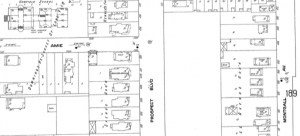
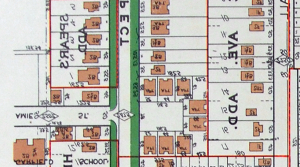
Figure 3
Analysis of 36th Street to 38th Street
For some, its just a rundown, unsafe, unhealthy portion of Kansas City that most people try to avoid to the best of their abilities. To others, its a historical place that was lively, beautiful, and friendly. The difference between which is time.
What once used to be a dense, residential and small business area, is now a vacant, overgrown sector of prospect that should be highly avoided at night time. in the photos below (Left: a photo of the intersection of 37th Street and Prospect. Right: Sanborn map of 1951) you can noticeably tell the difference between the densely packed and interactive layout of 1951, and the vacant, overgrown intersection it is now. The only thing that is still functioning in the picture below on the left is the Liberty Auto Sales and repair which has stood the test of time. After glancing at these images and the amount of decay that has occurred, it leads one to wish to see this section of Prospect in its heydays.
Historical Analysis Project.
East 60th / East 62nd and Prospect
For this project we were assigned the task of analyzing historical Sanborn maps and other data sources to observe how a particular assigned area in Kansas City has progressed over the years. Our observations would include things like changes in building density, road network changes, demographic changes, and any other changes in the assigned block group’s character. The particular area in Kansas City that I was assigned was the midtown Prospect boulevard area at East 60th street and East 62nd street.
At first glance of the site my initial impression of the site was that the area has seen a huge decline in population and that the area had drastically deteriorated. I formed this assumption because of the unkempt vegetation and the closed, boarded-up commercial buildings on the corner of Prospect and East 60th street as you can see in Figure 1.
Figure 1
Another surface level observation that I made was that there must have been a huge drop in density as there were many empty residential lots that still have driveways leading to the property from the streets but with no built structures there.
Digging a little deeper beyond the surface level data, I found some Sanborn maps that confirmed that there were actually houses in those now empty lots as you see in Figure 2 which is a Sanborn map from 1939.
Figure 2
In addition, doing some exploring in Google Earth Pro revealed that there was density in that immediate area up to as late as 205. After that you start to notice the demolition of the neighborhood. That is strange to me as this area of Kansas City isn’t extremely old or anything. It is in fact a little newer than many of the historical areas of Kansas City closer to the urban core that still stand to this day. I found this out by the lack of Sanborn map data prior to year 1939.
The only other year I was able to find Sanborn map data for was 1950. That particular map is almost identical to the map from year 1939. I infer this is because the bulk of change in the neighborhood didn’t happen until fairly recently. Around those two years is when the neighborhood was most like still new to the metropolitan area and things were still stable.
In summation of all the interesting data that I found for my neighborhood, I found that the East 60th and East 62nd blocks of Prospect Avenue have seen a drastic decline in population since 1939 when density in the neighborhood and Kansas City in general was more prevalent. Not the area is largely vacant and conditions similar of those in poverty.
Meyer Boulevard to 68th Street
Being quite far south compared to the Kansas City Proper, these blocks lack information about development in 1895 and 1909. Sanborn maps show the intention to develop this area in 1917, and by 1925 Prospect has been zoned commercial (where is remains today) and residences are popping up in the surroundings. These blocks continue to expand and develop over the next few decades. When the automobile transitions to primary transportation, this area of Prospect accommodates by widening the road. Growth spirals downward with the implementation of 71 Highway. Throughout the 1990’s homes are demolished and replaced with the highway. Since, there has been a continuous loss of population and density, leaving these blocks as primarily vacant land, automotive shops, and fast food restaurants. A figure ground study is drawn below to depict the low density. That isn’t to imply the area isn’t charming. Quaint commercial architecture still stands off Prospect. The Meyer boulevard transforms into a well designed bridge that carries cars, pedestrians, and cyclists safely above the highway. The Research College of Nursing provides an opportunity for steady pedestrian traffic.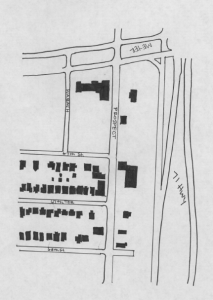
Historical Analysis of 63rd and E. Meyer Blvd
The area along Prospect that lies between 63rd and E. Meyer Blvd is dominated by the HCA Research Hospital which was established in 1963. When researching the maps and atlases it can be said that the block seemed to remain empty until the hospital was built.
Figure 1. The 1925 Atlas of 63rd and E. Meyer Blvd
As shown in figure 1. the area in 1925 was owned by J.J. Lyon but remained undeveloped.
Figure 2. The present day Hospital
Today the HCA Research Hospital occupies the entire area to the west of Prospect with the area to the east remaining empty except for one small building that is now a dance studio.
Prospect Avenue from 50th St. to 52nd St.
My blocks on Prospect Avenue were from 50th Street to 52nd Street. 50th Street is just a couple hundred feet south of where 71 curves and then crosses over Prospect Avenue. From my two blocks, especially between 50th and 51st St,you have a very good view of the looming highway.
The earliest record of my blocks I could find was from a Sanborn Fire Insurance Company map from 1917. Not much was located in my section yet, a few buildings were dotted along the east side of Prospect. One of these buildings was church.
Overtime, my blocks developed and more buildings, residential and business, sprang up. The church located there on the corner of 51st St on the east side of Prospect built a new building farther back from Prospect’s street-front. It was larger and indicates that people were moving to the area. This is a Sanborn Fire Insurance Company map from 1950.
In 1951, Kansas City officials started planning out a north-to-south freeway and it would forever change this area of Kansas City. Bruce R. Watkins Drive forced the clearing of large areas of developed neighborhoods. This “parkway” now divided an entire community. The church that had been growing here for decades was now gone, located directly in the highways path.
Cities are always changing and because of that the surrounding areas and neighborhoods around them are forced to change. It’s like a domino effect, one change leads to ripples of change throughout a community.
PROSPECT CORRIDOR ANALYSIS E 46TH STREET TO SWOPE PARKWAY
INTRODUCTION
Prospect Avenue is a major arterial road in Kansas City, Missouri, most known for the
devastated condition of its adjacent neighborhoods. The corridor runs north to south from about 12th Street to 75th Street. The development of adjacent neighborhoods largely began at Kansas City’s core, and graduated southward. This project intends to use maps and photographs to analyze the bordering Prospect blocks between E 46th Street and Swope Parkway in order to draw conclusions about historical development along the corridor.
Many of these blocks contain architecture that is emblematic of the Kansas City region. Since Kansas City’s development timeline generally runs north to south, there is a gradient in housing typology. The single-family homes in the study area are quite similar to much of the residential architecture in Kansas City’s midtown region. The figures above illustrate a home that is located on the corner of Prospect and Emanuel Cleaver Boulevard that existed in 1940, during which the Kansas City’s Tax Assessment photographs were taken. Many of the homes along the prospect corridor are historic and are expressive of the 20th century, as many residencies are in the prairie (above), bungalow, or foursquare architectural style.
Figure Ground Study
Unsurprisingly, the lots along this region of Prospect Avenue has increased in vacancy. The residential blocks along the corridor have suffered from disinvestment and mass-demolitions, and these blocks are expressive of that. However, the lots along Swope Parkway have established reverse patterns, as the block has become denser over time. This may be due to commercial and institutional land-use patterns along Swope, as well as higherdemands for property owners to be located on Brush Creek, located in-between Swope and Emanuel Cleaver II.
The east-side of Wabash Avenue shows a difference in density patterns. By referencing the figure-ground diagrams, we can see that the buildings on the southern part of Wabash have not been constructed yet. The homes along the north-part of Wabash Avenue have existed since the 1940s and are demonstrative in their architectural style. However, on the same street, we can see that newer development patterns are not only less dense, but contrast with the historic character of the neighborhood. It is a speculation that this type of development pattern may appear often along the corridor, as infill efforts in the blighted neighborhoods are financially challenged when constructing new homes.
Time Periods
First Record of Development (1917)
Volume 6 of the 1917 Sanborn collection
shows first signs of development on the
featured blocks. During this time, most of
the residential development was
happening along the adjacent streets,
rather than directly on Prospect. The
building footprints along Prospect show
some residential homes, but most of the
buildings are industrial land-uses centered
on intersections. The development near
Brush Creek (to the south) is very
limited, possibly due to flood hazards.
This era is characteristic of the early 1900s
during post-street car build-outs, but
pre-mail-order age.
1925 Atlas
By 1925, residencial density along
Prospect has increased. The the adjacent
blocks in this area seem to increase as well.
Although this era may be the peak of
residencial density in the zone, many of
the blocks that border Brush Creek
continue to go unused. The Country Club
Plaza opened two years prior to 1925 and
Brush Creek today acts as a major
predestrian connection to the district.
However, at this time, the creek was
unpaved and parcels along the Brush
Creek near Prospect probably faced the
threat of flood.
Figure 5. Sanborn Fire Insurance Maps. (1917).
Figure
Mid Century (1950s)
By mid-century, many of the lots adjacent to
Prospect Avenue began to fill up. Residential lots along Montgall, east of Prospect, are dense, while the western block of Wabash sees little growth. This is contrary to present-day trends, where development interests tend to shift
westward. These patterns may be explained by flooding hazards along the creek.
However, there is evidence from the Jackson County 1940s Tax Assessment photos that there was institutional development trends along the south-side of Brush Creek, just south of the study-area. This development may have been motivated by the recent paving of Brush Creek, which occured during the 1930s. Mary’s
Catholic Church (figure), which no longer
exists, was located at 2322 Swope Parkway during the 1940s.
Today, the stretch on Prospect Avenue
between 46th and Swope contains some of the only vibrant green spaces on the corridor. The trails along Brush Creek provides apedestrian connection to the West-side of town, and can be seen as a landmark on the corridor. However, the creek may indicate an edge that partners with 71-Highway individing the corridor. The neighborhoods north of the creek are dense and highly residential on both sides of the corridor. Looking south, 71-Highway abruptly crosses Prospect and runs along it, dividing the neighborhoods.The study area between 46th and Swope is not highly representative of the Prospect corridor. Emanuel Cleaver II Blvd and Swope Parkway are two major arterial roads that act as east-west connectors and run along Brush Creek, a staple of Kansas City. The east-west roads that run along Brush Creek seem to get more attention from the city in an attempt to preserve scenic views.However, many of the lots in this area remain vacant, or not taken care of well. There is also a small commercial strip that containsbuildings whose structural integrity seems to have been neglected.
E.44th St. To E.46th St.
The first map that I was able to find for my blocks was the 1909-1917 Sanborn Fire Insurance Maps. According to the map there wasn’t very much development on E. 44th Street to E. 46th Street. There was a blacksmith shop with a coal shed, a feed store, a henhouse and only nine houses on the Prospect from 44th Street to 45th Street. The blacksmith and feed store in the maps gave me the idea that cars weren’t very popular at the time due to them maybe being expensive and still a brand new inventions. kansascity1906-1917vol-61917sheet776
